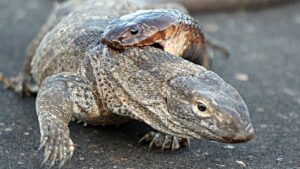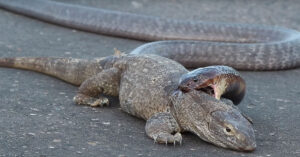Have you ever pondered whether a monitor lizard is immune to cobra venom? It’s a captivating question that delves into the intricacies of the natural world. Imagine a clash between these two apex predators, each wielding its own unique arsenal of survival tactics. But amidst the drama, the crucial question remains: Is a monitor lizard truly immune to cobra venom?
Monitor lizards, particularly species like the Asian water monitor and the Nile monitor, have shown remarkable resistance to certain types of venom, including that of cobras. While they’re not completely immune to cobra venom, they do possess a high level of resistance due to various physiological factors.
Research suggests that monitor lizards have evolved specific adaptations to cope with venomous snake bites. One key adaptation is their efficient circulatory system, which helps slow down the spread of venom throughout their bodies. Additionally, monitor lizards have strong immune systems that can neutralize or tolerate certain toxins to some extent.
However, it’s essential to note that the degree of resistance varies among individual lizards and the potency of the venom. So while monitor lizards may have some level of protection against cobra venom, it’s not absolute immunity.
Understanding Monitor Lizards

Monitor lizards are a fascinating group of reptiles belonging to the family Varanidae, known for their impressive size, intelligence, and adaptability. These creatures are found in various habitats across Africa, Asia, and Australia, thriving in diverse environments ranging from forests and savannas to deserts and mangroves.
One of the most iconic members of this family is the Komodo dragon, the largest living lizard species, native to Indonesia. However, numerous other species, such as the Nile monitor, Asian water monitor, and Savannah monitor, also captivate researchers and enthusiasts alike with their unique characteristics.
These reptiles are carnivorous predators, feeding on a wide range of prey, including insects, small mammals, birds, eggs, and even carrion. Their sharp claws, powerful jaws, and keen senses make them formidable hunters in their respective ecosystems.
Monitor lizards are renowned for their intelligence and problem-solving abilities. They exhibit complex behaviors such as tool use, learning, and social interactions, challenging the traditional notion of reptiles as simple creatures driven purely by instinct.
In terms of anatomy, monitor lizards possess long bodies, muscular limbs, and elongated necks topped with elongated heads housing sharp teeth. Their tongues are forked, aiding in olfactory detection, while their strong tails serve multiple purposes, from balance and defense to communication.
While monitor lizards are generally solitary, they may come together for breeding or during resource-rich seasons. Reproduction typically involves courtship displays, followed by egg-laying in underground nests. Some species, like the Komodo dragon, are capable of parthenogenesis, allowing females to produce offspring without mating.
Despite their remarkable adaptations and widespread distribution, monitor lizards face various threats, including habitat loss, hunting for their skins and meat, and persecution due to conflicts with humans. Conservation efforts aim to mitigate these challenges and ensure the survival of these extraordinary reptiles for generations to come.
Is a monitor lizard immune to cobra venom?
Monitor lizards, including species like the Komodo dragon, have long been rumored to be immune to cobra venom. While they do possess a remarkable resistance to certain types of venom, including that of cobras, they are not completely immune.
Research suggests that monitor lizards have evolved physiological adaptations that provide them with a degree of protection against venomous snake bites. One such adaptation is their efficient circulatory system, which helps slow down the spread of venom throughout their bodies. Additionally, monitor lizards have strong immune systems that can neutralize or tolerate certain toxins to some extent.
However, this resistance varies among individual lizards and the potency of the venom. While some monitor lizards may survive cobra venom bites with relatively minor effects, others may succumb to the venom’s lethal effects.
It’s also important to note that while monitor lizards may have evolved some level of resistance to cobra venom, they are not actively seeking out cobras as prey. Encounters between these two predators are relatively rare in the wild, and monitor lizards typically avoid confrontations with venomous snakes when possible.
Overall, while monitor lizards possess remarkable adaptations to cope with venomous snake bites, they are not immune to cobra venom, and the outcome of such encounters can vary depending on multiple factors.
Effects of cobra venom on prey and predators

Cobra venom is a potent cocktail of toxins designed to immobilize and kill prey quickly. Its effects vary depending on factors such as the species of cobra, the amount of venom injected, and the size and species of the victim. Here’s a breakdown of the effects of cobra venom on both prey and predators:
Prey:
- Neurotoxic Effects: Cobra venom contains neurotoxins that target the nervous system, causing paralysis. This paralysis starts with the muscles closest to the bite site and progresses rapidly, eventually leading to respiratory failure and death if left untreated.
- Cardiotoxic Effects: Some cobras produce cardiotoxins that affect the victim’s cardiovascular system, leading to cardiac arrest or circulatory collapse.
- Hemotoxic Effects: In addition to neurotoxins and cardiotoxins, some cobras have hemotoxic components in their venom, which can cause tissue damage, internal bleeding, and organ failure.
Overall, the combination of these toxins results in a swift and efficient means of subduing prey, allowing the cobra to consume it without resistance.
Predators:
- Variable Effects: The effects of cobra venom on predators can vary widely depending on factors such as the predator’s species, size, and resistance to venom.
- Potential Lethality: For predators lacking resistance or immunity to cobra venom, a bite can be lethal. The neurotoxic and cardiotoxic effects can quickly incapacitate the predator, leading to its demise.
- Resistance in Some Predators: Certain predators, such as some species of monitor lizards, have developed varying degrees of resistance to cobra venom. While they may not be completely immune, their physiological adaptations enable them to survive or tolerate cobra bites to some extent.
- Avoidance Behavior: Many predators, even those capable of resisting cobra venom, may avoid confrontation with cobras due to the potential risks involved. This avoidance behavior helps minimize the chances of injury or death from a venomous snake bite.

